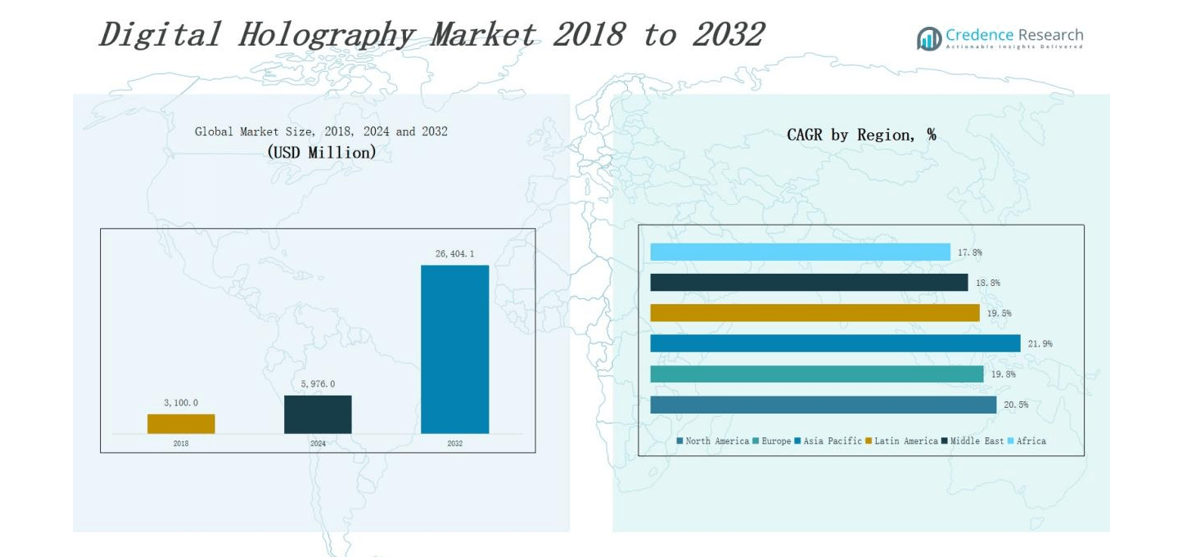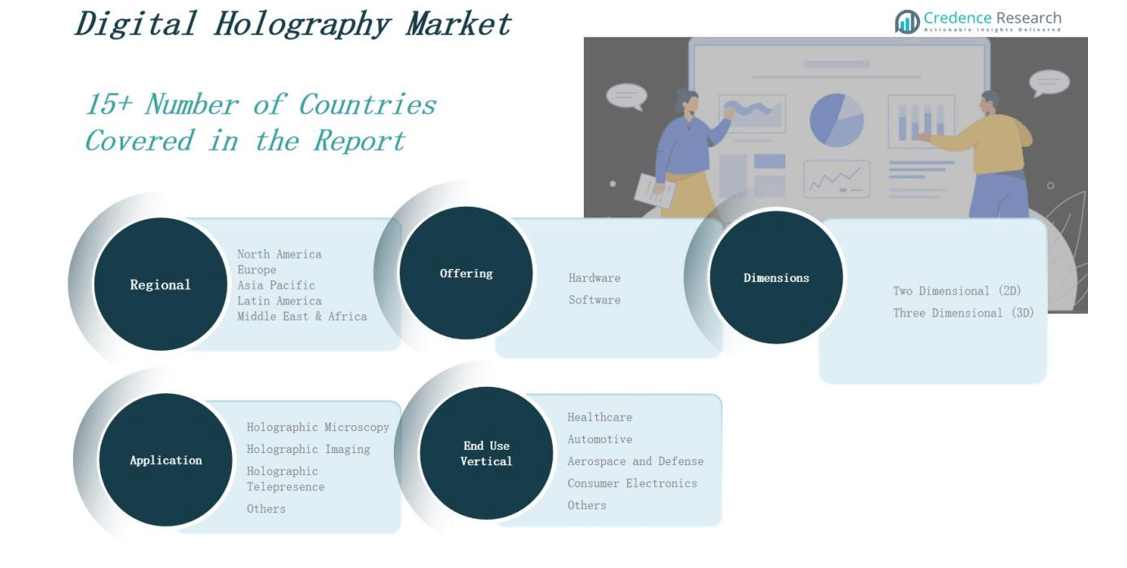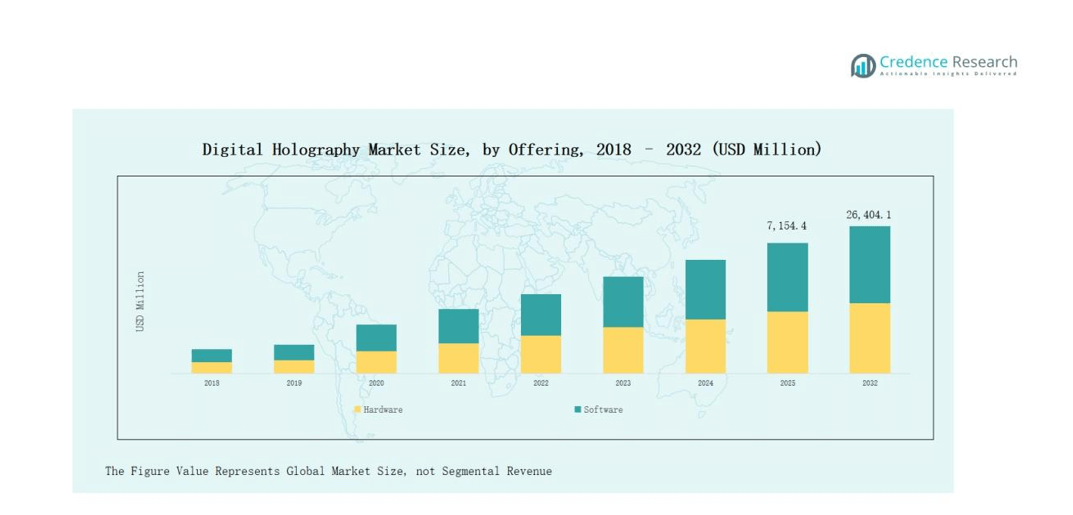CHAPTER NO. 1 : GENESIS OF THE MARKET
1.1 Market Prelude – Introduction & Scope
1.2 The Big Picture – Objectives & Vision
1.3 Strategic Edge – Unique Value Proposition
1.4 Stakeholder Compass – Key Beneficiaries
CHAPTER NO. 2 : EXECUTIVE LENS
2.1 Pulse of the Industry – Market Snapshot
2.2 Growth Arc – Revenue Projections (USD Million)
2.3. Premium Insights – Based on Primary Interviews
CHAPTER NO. 3 : DIGITAL HOLOGRAPHY MARKET FORCES & INDUSTRY PULSE
3.1 Foundations of Change – Market Overview
3.2 Catalysts of Expansion – Key Market Drivers
3.2.1 Momentum Boosters – Growth Triggers
3.2.2 Innovation Fuel – Disruptive Technologies
3.3 Headwinds & Crosswinds – Market Restraints
3.3.1 Regulatory Tides – Compliance Challenges
3.3.2 Economic Frictions – Inflationary Pressures
3.4 Untapped Horizons – Growth Potential & Opportunities
3.5 Strategic Navigation – Industry Frameworks
3.5.1 Market Equilibrium – Porter’s Five Forces
3.5.2 Ecosystem Dynamics – Value Chain Analysis
3.5.3 Macro Forces – PESTEL Breakdown
3.6 Price Trend Analysis
3.6.1 Regional Price Trend
3.6.2 Price Trend by product
CHAPTER NO. 4 : KEY INVESTMENT EPICENTER
4.1 Regional Goldmines – High-Growth Geographies
4.2 Offering Frontiers – Lucrative Offering Categories
4.3 Dimensions Sweet Spots – Emerging Demand Segments
CHAPTER NO. 5: REVENUE TRAJECTORY & WEALTH MAPPING
5.1 Momentum Metrics – Forecast & Growth Curves
5.2 Regional Revenue Footprint – Market Share Insights
5.3 Segmental Wealth Flow – Offering & Dimensions Revenue
CHAPTER NO. 6 : TRADE & COMMERCE ANALYSIS
6.1. Import Analysis by Region
6.1.1. Global Digital Holography Market Import Revenue By Region
6.2. Export Analysis by Region
6.2.1. Global Digital Holography Market Export Revenue By Region
CHAPTER NO. 7 : COMPETITION ANALYSIS
7.1. Company Market Share Analysis
7.1.1. Global Digital Holography Market: Company Market Share
7.2. Global Digital Holography Market Company Revenue Market Share
7.3. Strategic Developments
7.3.1. Acquisitions & Mergers
7.3.2. New Offering Launch
7.3.3. Regional Expansion
7.4. Competitive Dashboard
7.5. Company Assessment Metrics, 2024
CHAPTER NO. 8 : DIGITAL HOLOGRAPHY MARKET – BY OFFERING SEGMENT ANALYSIS
8.1. Digital Holography Market Overview by Offering Segment
8.1.1. Digital Holography Market Revenue Share By Offering
8.2. Hardware
8Software
CHAPTER NO. 9 : DIGITAL HOLOGRAPHY MARKET – BY DIMENSIONS SEGMENT ANALYSIS
9.1. Digital Holography Market Overview by Dimensions Segment
9.1.1. Digital Holography Market Revenue Share By Dimensions
9.2. Two Dimensional (2D)
9.3. Three Dimensional (3D)
CHAPTER NO. 10 : DIGITAL HOLOGRAPHY MARKET – BY END USE VERTICAL SEGMENT ANALYSIS
10.1. Digital Holography Market Overview by End Use Vertical Segment
10.1.1. Digital Holography Market Revenue Share By End Use Vertical
10.2. Healthcare
10.3. Automotive
10.4. Aerospace and Defense
10.5. Consumer Electronics
10.6. Others
CHAPTER NO. 11 : DIGITAL HOLOGRAPHY MARKET – BY APPLICATION SEGMENT ANALYSIS
11.1. Digital Holography Market Overview by Application Segment
11.1.1. Digital Holography Market Revenue Share By Application
11.2. Holographic Microscopy
11.3. Holographic Imaging
11.4. Holographic Telepresence
11.5. Others
CHAPTER NO. 12 : DIGITAL HOLOGRAPHY MARKET – REGIONAL ANALYSIS
12.1. Digital Holography Market Overview by Region Segment
12.1.1. Global Digital Holography Market Revenue Share By Region
12.1.2. Regions
12.1.3. Global Digital Holography Market Revenue By Region
12.1.4. Offering
12.1.5. Global Digital Holography Market Revenue By Offering
12.1.6. Dimensions
12.1.7. Global Digital Holography Market Revenue By Dimensions
12.1.8. End Use Vertical
12.1.9. Global Digital Holography Market Revenue By End Use Vertical
12.1.10. Application
12.1.11. Global Digital Holography Market Revenue By Application
CHAPTER NO. 13 : NORTH AMERICA DIGITAL HOLOGRAPHY MARKET – COUNTRY ANALYSIS
13.1. North America Digital Holography Market Overview by Country Segment
13.1.1. North America Digital Holography Market Revenue Share By Region
13.2. North America
13.2.1. North America Digital Holography Market Revenue By Country
13.2.2. Offering
13.2.3. North America Digital Holography Market Revenue By Offering
13.2.4. Dimensions
13.2.5. North America Digital Holography Market Revenue By Dimensions
13.2.6. End Use Vertical
13.2.7. North America Digital Holography Market Revenue By End Use Vertical
13.2.8. Application
13.2.9. North America Digital Holography Market Revenue By Application
13.3. U.S.
13.4. Canada
13.5. Mexico
CHAPTER NO. 14 : EUROPE DIGITAL HOLOGRAPHY MARKET – COUNTRY ANALYSIS
14.1. Europe Digital Holography Market Overview by Country Segment
14.1.1. Europe Digital Holography Market Revenue Share By Region
14.2. Europe
14.2.1. Europe Digital Holography Market Revenue By Country
14.2.2. Offering
14.2.3. Europe Digital Holography Market Revenue By Offering
14.2.4. Dimensions
14.2.5. Europe Digital Holography Market Revenue By Dimensions
14.2.6. End Use Vertical
14.2.7. Europe Digital Holography Market Revenue By End Use Vertical
14.2.8. Application
14.2.9. Europe Digital Holography Market Revenue By Application
14.3. UK
14.4. France
14.5. Germany
14.6. Italy
14.7. Spain
14.8. Russia
14.9. Rest of Europe
CHAPTER NO. 15 : ASIA PACIFIC DIGITAL HOLOGRAPHY MARKET – COUNTRY ANALYSIS
15.1. Asia Pacific Digital Holography Market Overview by Country Segment
15.1.1. Asia Pacific Digital Holography Market Revenue Share By Region
15.2. Asia Pacific
15.2.1. Asia Pacific Digital Holography Market Revenue By Country
15.2.2. Offering
15.2.3. Asia Pacific Digital Holography Market Revenue By Offering
15.2.4. Dimensions
15.2.5. Asia Pacific Digital Holography Market Revenue By Dimensions
15.2.6. End Use Vertical
15.2.7. Asia Pacific Digital Holography Market Revenue By End Use Vertical
15.2.8. Application
15.2.9. Asia Pacific Digital Holography Market Revenue By Application
15.3. China
15.4. Japan
15.5. South Korea
15.6. India
15.7. Australia
15.8. Southeast Asia
15.9. Rest of Asia Pacific
CHAPTER NO. 16 : LATIN AMERICA DIGITAL HOLOGRAPHY MARKET – COUNTRY ANALYSIS
16.1. Latin America Digital Holography Market Overview by Country Segment
16.1.1. Latin America Digital Holography Market Revenue Share By Region
16.2. Latin America
16.2.1. Latin America Digital Holography Market Revenue By Country
16.2.2. Offering
16.2.3. Latin America Digital Holography Market Revenue By Offering
16.2.4. Dimensions
16.2.5. Latin America Digital Holography Market Revenue By Dimensions
16.2.6. End Use Vertical
16.2.7. Latin America Digital Holography Market Revenue By End Use Vertical
16.2.8. Application
16.2.9. Latin America Digital Holography Market Revenue By Application
16.3. Brazil
16.4. Argentina
16.5. Rest of Latin America
CHAPTER NO. 17 : MIDDLE EAST DIGITAL HOLOGRAPHY MARKET – COUNTRY ANALYSIS
17.1. Middle East Digital Holography Market Overview by Country Segment
17.1.1. Middle East Digital Holography Market Revenue Share By Region
17.2. Middle East
17.2.1. Middle East Digital Holography Market Revenue By Country
17.2.2. Offering
17.2.3. Middle East Digital Holography Market Revenue By Offering
17.2.4. Dimensions
17.2.5. Middle East Digital Holography Market Revenue By Dimensions
17.2.6. End Use Vertical
17.2.7. Middle East Digital Holography Market Revenue By End Use Vertical
17.2.8. Application
17.2.9. Middle East Digital Holography Market Revenue By Application
17.3. GCC Countries
17.4. Israel
17.5. Turkey
17.6. Rest of Middle East
CHAPTER NO. 18 : AFRICA DIGITAL HOLOGRAPHY MARKET – COUNTRY ANALYSIS
18.1. Africa Digital Holography Market Overview by Country Segment
18.1.1. Africa Digital Holography Market Revenue Share By Region
18.2. Africa
18.2.1. Africa Digital Holography Market Revenue By Country
18.2.2. Offering
18.2.3. Africa Digital Holography Market Revenue By Offering
18.2.4. Dimensions
18.2.5. Africa Digital Holography Market Revenue By Dimensions
18.2.6. End Use Vertical
18.2.7. Africa Digital Holography Market Revenue By End Use Vertical
18.2.8. Application
18.2.9. Africa Digital Holography Market Revenue By Application
18.3. South Africa
18.4. Egypt
18.5. Rest of Africa
CHAPTER NO. 19 : COMPANY PROFILES
19.1. Lyncée Tec SA
19.1.1. Company Overview
19.1.2. Offering Portfolio
19.1.3. Financial Overview
19.1.4. Recent Developments
19.1.5. Growth Strategy
19.1.6. SWOT Analysis
19.2. RealView Imaging Ltd.
19.3. EON Reality
19.4. Phase Holographic Imaging PHI AB
19.5. Holotech
19.6. Holmarc Opto-Mechatronics Ltd.
19.7. Geola
19.8. Leia Inc.
19.9. Ovizio
19.10. Himax Technologies, Inc.
19.11. MetroLaser
19.12. HYPERVSN
19.13. SAMSUNG
19.14. Meta










